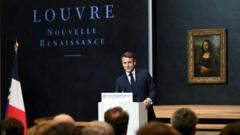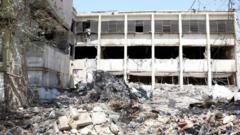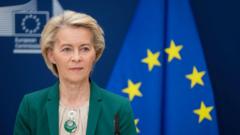The Louvre's renowned Mona Lisa will find a new home as part of an extensive renovation plan aimed at improving visitor experience and museum infrastructure.
**Mona Lisa's Relocation Announced Amid Louvre Renovation Plans**

**Mona Lisa's Relocation Announced Amid Louvre Renovation Plans**
President Macron proposes major overhaul of the Louvre, including moving the iconic painting.
The iconic Mona Lisa will be relocated to a new exhibition space within the Louvre Museum in Paris as part of a comprehensive renovation project set to unfold over the coming years. French President Emmanuel Macron announced this significant change during an event held in front of the famous painting, addressing a gathering of dignitaries and museum officials. The move, expected to be completed by 2031, will involve additional admission fees for visitors wishing to see the masterpiece.
Macron unveiled the initiative, dubbed the "New Renaissance," which intends to tackle various challenges the museum faces, particularly overcrowding and outdated infrastructure. Daily visitor numbers at the Louvre have reached around 30,000, with more than nine million people annually, making it the most visited museum in the world. Louvre Director Laurence des Cars recently highlighted severe issues related to the museum’s capacity and the presentation of the Mona Lisa, which currently sees a majority of visitors funnel through with very limited time to take in the painting.
Plans under the New Renaissance project will also include the creation of a new entrance to ease the pressure created by the glass Pyramid, along with substantial renovations to modernize facilities. An international competition will be launched to design the entrance as part of the museum's redesign. Furthermore, beginning in January 2024, non-EU visitors, including UK tourists, will face increased entry tariffs as part of the initiative.
The Louvre plans extensive upgrades to enhance visitor services, with the overall renovation costs expected to reach several hundred million euros. Macron emphasized that the funding will come from ticket sales, donations, and sponsorship from the Louvre Abu Dhabi, meaning no burden will fall on taxpayers.
As Macron's political power diminishes following losses in parliamentary control, the Louvre renovation serves as a part of his efforts to bolster his legacy, akin to his successful management of the Notre-Dame cathedral's post-fire restoration. The developments signal significant changes in how the Louvre will engage with both its visitors and the broader Parisian community in the coming years.
Macron unveiled the initiative, dubbed the "New Renaissance," which intends to tackle various challenges the museum faces, particularly overcrowding and outdated infrastructure. Daily visitor numbers at the Louvre have reached around 30,000, with more than nine million people annually, making it the most visited museum in the world. Louvre Director Laurence des Cars recently highlighted severe issues related to the museum’s capacity and the presentation of the Mona Lisa, which currently sees a majority of visitors funnel through with very limited time to take in the painting.
Plans under the New Renaissance project will also include the creation of a new entrance to ease the pressure created by the glass Pyramid, along with substantial renovations to modernize facilities. An international competition will be launched to design the entrance as part of the museum's redesign. Furthermore, beginning in January 2024, non-EU visitors, including UK tourists, will face increased entry tariffs as part of the initiative.
The Louvre plans extensive upgrades to enhance visitor services, with the overall renovation costs expected to reach several hundred million euros. Macron emphasized that the funding will come from ticket sales, donations, and sponsorship from the Louvre Abu Dhabi, meaning no burden will fall on taxpayers.
As Macron's political power diminishes following losses in parliamentary control, the Louvre renovation serves as a part of his efforts to bolster his legacy, akin to his successful management of the Notre-Dame cathedral's post-fire restoration. The developments signal significant changes in how the Louvre will engage with both its visitors and the broader Parisian community in the coming years.






















